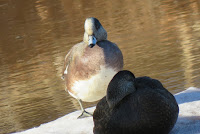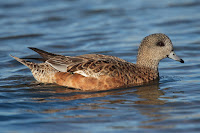AMERICAN WIGEON
AMERICAN WIGEON (Mareca americana) – (See images below)
DESCRIPTION: The American Wigeon is a medium-sized dabbling duck. In terms of size it is between a teal (smaller) and a pintail (larger). The drake has a green patch behind the eyes and a large whitish band from the cap down to the bill. The cheeks, neck and throat are finely striated black and white. The flanks are rusty brown and the back and wings are brown, with the secondary coverts white and the secondaries dark brown. The under parts are white and the rump is black. The bill is white with a black tip. Non-breeding males are similar to females. The female is reddish brown with a grey head and neck with fine white barring. the under parts are white. Its bill is grey with a black tip. The legs and feet are grey. This duck is approximately 20 inches (50 cm) long.
VOICE: https://www.xeno-canto.org/species/Mareca-americana. Males are noisy whistlers, whereas females emit more typical ‘quacks’ for a duck.
NAME: The English name ‘Wigeon’ is from French ‘vigeon’, which means a whistling duck. The Latin genus name ‘Mareca’ is from Portuguese and means a small duck. Whenever a location name such as a continent or cardinal direction is part of a bird’s name, it implies that there are other species of the same genus in other locations. In this case here we have the ‘American’ wigeon, and there’s also the ‘Eurasian’ Wigeon.
HABITAT: Wetlands in open areas, either fresh or saltwater marshes.
DIET: The American wigeon has a bill with features that help it tear away at vegetation, which is the bulk of its diet during the non-breeding season. When breeding, the female and ducklings will also add invertebrates to their menu. Wigeons eat at night as well, especially during hunting season.
NESTING: The nest is a shallow depression in a well-hidden area not far from water. It is lined with the duck’s down. An average of 10 white eggs are laid The female is the main caregiver.
DISTRIBUTION: This wigeon breeds in the Arctic and migrates some distance south for the winter, mainly along the western part of America. Some individuals will spend the winter even further south, including on Hawaii.
DISTRIBUTION MAP: https://en.wikipedia.org/wiki/American_wigeon#/media/File:Mareca_americana_map.svg
ON PEI: The American wigeon breeds on Prince Edward Island and is very common through all seasons except in the winter, where they are uncommon to rare.
CONSERVATION: The American wigeon is among the five most (legally) hunted duck species in North America. Its population has steadily declined over the last few decades, one factor being loss of habitat to agriculture by drainage of wetlands. Another factor is droughts in the Prairie region during some summers. In spite of these issues the species is still listed as ‘least concern’.
NOTES: On their wintering grounds American wigeons gather in large groups and congregate with other migratory duck species.
SIMILAR SPECIES: Eurasian Wigeon
REFERENCES: https://en.wikipedia.org/wiki/American_wigeon
https://www.ducks.ca/species/american-wigeon/
http://www.birdweb.org/birdweb/bird/american_wigeon
https://www.allaboutbirds.org/guide/American_Wigeon/overview
https://identify.whatbird.com/obj/94/_/American_Wigeon.aspx
https://www.coniferousforest.com/american-wigeon.htm
https://www.borealbirds.org/bird/american-wigeon
Here's a video of the male above foraging at Ellen's Creek, and picking some dead piece of vegetation in the end:
This other video shows the same duck after landing beside a (half)sleeping American Black Duck, and then self-preening:
DESCRIPTION: The American Wigeon is a medium-sized dabbling duck. In terms of size it is between a teal (smaller) and a pintail (larger). The drake has a green patch behind the eyes and a large whitish band from the cap down to the bill. The cheeks, neck and throat are finely striated black and white. The flanks are rusty brown and the back and wings are brown, with the secondary coverts white and the secondaries dark brown. The under parts are white and the rump is black. The bill is white with a black tip. Non-breeding males are similar to females. The female is reddish brown with a grey head and neck with fine white barring. the under parts are white. Its bill is grey with a black tip. The legs and feet are grey. This duck is approximately 20 inches (50 cm) long.
VOICE: https://www.xeno-canto.org/species/Mareca-americana. Males are noisy whistlers, whereas females emit more typical ‘quacks’ for a duck.
NAME: The English name ‘Wigeon’ is from French ‘vigeon’, which means a whistling duck. The Latin genus name ‘Mareca’ is from Portuguese and means a small duck. Whenever a location name such as a continent or cardinal direction is part of a bird’s name, it implies that there are other species of the same genus in other locations. In this case here we have the ‘American’ wigeon, and there’s also the ‘Eurasian’ Wigeon.
HABITAT: Wetlands in open areas, either fresh or saltwater marshes.
DIET: The American wigeon has a bill with features that help it tear away at vegetation, which is the bulk of its diet during the non-breeding season. When breeding, the female and ducklings will also add invertebrates to their menu. Wigeons eat at night as well, especially during hunting season.
NESTING: The nest is a shallow depression in a well-hidden area not far from water. It is lined with the duck’s down. An average of 10 white eggs are laid The female is the main caregiver.
DISTRIBUTION: This wigeon breeds in the Arctic and migrates some distance south for the winter, mainly along the western part of America. Some individuals will spend the winter even further south, including on Hawaii.
DISTRIBUTION MAP: https://en.wikipedia.org/wiki/American_wigeon#/media/File:Mareca_americana_map.svg
ON PEI: The American wigeon breeds on Prince Edward Island and is very common through all seasons except in the winter, where they are uncommon to rare.
CONSERVATION: The American wigeon is among the five most (legally) hunted duck species in North America. Its population has steadily declined over the last few decades, one factor being loss of habitat to agriculture by drainage of wetlands. Another factor is droughts in the Prairie region during some summers. In spite of these issues the species is still listed as ‘least concern’.
NOTES: On their wintering grounds American wigeons gather in large groups and congregate with other migratory duck species.
SIMILAR SPECIES: Eurasian Wigeon
REFERENCES: https://en.wikipedia.org/wiki/American_wigeon
https://www.ducks.ca/species/american-wigeon/
http://www.birdweb.org/birdweb/bird/american_wigeon
https://www.allaboutbirds.org/guide/American_Wigeon/overview
https://identify.whatbird.com/obj/94/_/American_Wigeon.aspx
https://www.coniferousforest.com/american-wigeon.htm
https://www.borealbirds.org/bird/american-wigeon
 |
| American Wigeon carrying vegetation Ellen's Creek, PEI |
 |
| American Wigeon, front view with American Black Duck - Ellen's Creek, PEI |
 |
| American Wigeon male, Ellen's Creek, PEI |
 |
| Male American Wigeon has black legs |
 |
| American Wigeon, female – Humber Bay Park, Toronto, ON photo by Mdf |
 |
| American Wigeon drake – Westchester Lagoon Anchorage, AK - Donna Dewhurst, USFWS |
Here's a video of the male above foraging at Ellen's Creek, and picking some dead piece of vegetation in the end:
This other video shows the same duck after landing beside a (half)sleeping American Black Duck, and then self-preening: